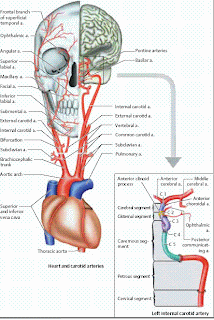Blood is pumped from the left ventricle of the heart to the aortic arch and thence to the common carotid arteries and anterior circulation of the brain (internal carotid, middle cerebral, and anterior cerebral arteries), and to the subclavian
arteries and posterior circulation of the brain (vertebral, basilar, and posterior cerebral arteries).
The anterior circulation supplies the eyes, basal ganglia, part of the hypothalamus, the frontal and parietal lobes, and a large portion of the temporal lobes, while the posterior circulation supplies the brain stem, cerebellum, inner
ear, occipital lobes, the thalamus, part of the hypothalamus, and a smaller portion of the temporal lobes. Venous blood from the superficial and deep cerebral veins (p. 18 ff) drains via the dural venous sinuses into the internal jugular veins and thence into the the superior vena cava and right atrium. The extracranial and intracranial portions of the blood supply of the brain as well as that of the spinal cord will be detailed further in the following paragraphs.
Carotid Arteries: Extracranial Portion
The brachiocephalic trunk arises from the aortic arch behind the manubrium of the sternum and bifurcates at the level of the sternoclavicular joint to form the right subclavian and common carotid arteries. The left common carotid artery
(usually adjacent to the brachiocephalic trunk) and subclavian artery arise directly from the aortic arch. The common carotid artery on either side bifurcates at the level of the thyroid cartilage to form the internal and external carotid
arteries; these arteries lie parallel and adjacent to each other after the bifurcation, with the external carotid artery lyingmedial. A dilatation of the common carotid artery at its bifurcation is called the carotid sinus. The external carotid artery gives off the superior thyroid, lingual, facial, and maxillary arteries anteriorly, the ascending pharyngeal artery medially, and the occipital and posterior auricular
arteries posteriorly. The maxillary and superficial temporal arteries are its terminal branches. The middle meningeal artery is an important branch of the maxillary artery. The internal carotid artery gives off no extracranial branches. Its cervical portion runs lateral or dorsolateral to the external carotid artery, then dorsomedially along the wall of the pharynx (parapharyngeal space) in front of the transverse processes of the first three cervical vertebrae, and finally curves medially toward the carotid foramen.
Carotid Arteries: Intracranial Portion
The internal carotid artery (ICA) passes through the base of the skull in the carotid canal, which lies within the petrous part of the temporal bone. It runs upward about 1 cm, then turns anteromedially and courses toward the petrous
apex, where it emerges from the temporal bone to enter the cavernous sinus. Within the sinus, the ICA runs along the lateral surface of the body of the sphenoid bone (C5 segment of the ICA), then turns anteriorly and passes lateral to the sella turcica along the lateral wall of the sphenoid bone (segment C4). It then bends sharply back on itself under the root of the anterior clinoid process, so that it points posteriorly (segment C3, carotid bend). After emerging from the cavernous sinus, it penetrates the dura mater medial to the anterior clinoid process and passes under the optic nerve (cisternal segment, segment C2). It then ascends in the subarachnoid space (segment C1) till it reaches the circle ofWillis, the site of its terminal bifurcation.Segments C3, C4, and C5 of the ICA constitute its infraclinoid segment, segments C1 and C2 its supraclinoid segment. Segments C2, C3, and C4 together make up the carotid siphon. The ophthalmic artery arises from the carotid bend and runs in the optic canal inferior to the
optic nerve. One of its ocular branches, the central retinal artery, passes together with the optic nerve to the retina, where it can be seen by ophthalmoscopy.
Medial to the clinoid process, the posterior communicating artery arises from the posterior wall of the internal carotid artery, passes posteriorly in proximity to the oculomotor nerve, and then joins the posterior cerebral artery. The anterior choroidal artery usually arises from the ICA and rarely from the middle cerebral
artery. It crosses under the optic tract, passes laterally to the crus cerebri and lateral geniculate body, and enters the inferior horn of the lateral ventricle, where it joins the tela choroidea.











0 comments:
Post a Comment